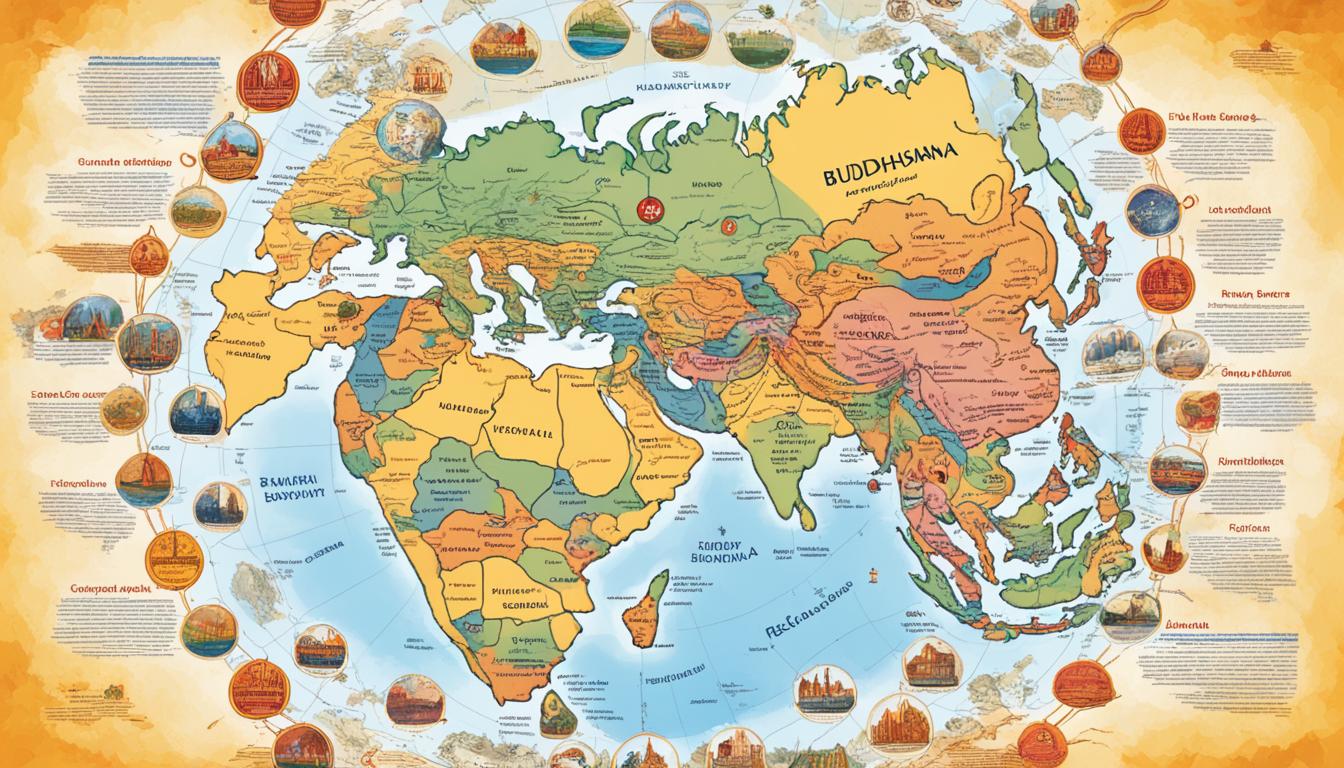“Thousands of candles can be lit from a single candle, and the life of the candle will not be shortened. Happiness never decreases by being shared.” – Buddha
Buddhism, one of the world’s major religions, has a profound impact on millions of lives around the globe. This ancient spiritual tradition, rooted in the teachings of Gautama Buddha, offers wisdom and guidance for those seeking inner peace and enlightenment. If you’ve ever wondered where Buddhism is most prevalent today, we have the answers for you.
From the towering peaks of the Himalayas to the bustling streets of major cities, Buddhism has found its home in various corners of the world. By exploring its distribution, we can gain a deeper understanding of its reach and influence. So, let’s embark on a journey to uncover the major Buddhist countries and where Buddhism holds a prominent place in the hearts and minds of individuals.
Key Takeaways:
- Asia-Pacific is the region with the highest concentration of Buddhists, accounting for about 99% of the total Buddhist population.
- The three major branches of Buddhism are Mahayana, Theravada, and Vajrayana, with Mahayana being the largest branch.
- Mahayana Buddhism is prevalent in countries like China, Japan, South Korea, and Vietnam.
- Theravada Buddhism is concentrated in Thailand, Burma (Myanmar), Sri Lanka, Laos, and Cambodia.
- Vajrayana Buddhism is found in Tibet, Nepal, Bhutan, and Mongolia.
Buddhism in Asia-Pacific
Asia-Pacific is the heartland of Buddhism, with a significant number of Buddhists residing in this region. In fact, the top 10 countries with the largest Buddhist populations are all located in Asia-Pacific. China, in particular, is home to the largest number of Buddhists, with half of the world’s Buddhist population residing in this country. Other countries in Asia-Pacific with significant Buddhist populations include Thailand, Japan, Burma (Myanmar), Sri Lanka, Vietnam, Cambodia, South Korea, India, and Malaysia. Together, these countries collectively account for 95% of all Buddhists worldwide.
Let’s take a closer look at the top countries in Asia-Pacific with the highest Buddhist population:
| Country | Buddhist Population | Buddhist Majority |
|---|---|---|
| China | Approximately 244 million | No |
| Thailand | Approximately 64 million | Yes |
| Japan | Approximately 45 million | No |
| Burma (Myanmar) | Approximately 38 million | Yes |
| Sri Lanka | Approximately 22 million | Yes |
| Vietnam | Approximately 16 million | No |
| Cambodia | Approximately 15 million | Yes |
| South Korea | Approximately 11 million | No |
| India | Approximately 10 million | No |
| Malaysia | Approximately 5 million | No |
It is interesting to note that seven countries in Asia-Pacific have a Buddhist majority, namely Cambodia, Thailand, Burma (Myanmar), Bhutan, Sri Lanka, Laos, and Mongolia. This signifies the cultural and religious significance of Buddhism in these countries.
Buddhism Outside of Asia-Pacific
While the majority of Buddhists reside in Asia-Pacific, Buddhism also has a presence outside of this region. North America and Europe have over 1 million Buddhists each.
In North America, approximately 3.9 million people identify as Buddhists, which accounts for about 1% of the population. In Europe, there are around 1.3 million Buddhists, also representing about 1% of the population.
In other regions, such as Africa, Latin America, and the Middle East, the Buddhist population is less than 1% of the total population.
Buddhism in North America
In North America, Buddhism has gained a significant following. The practice of Buddhism in this region is diverse, with various traditions and branches being represented. Buddhist communities and centers can be found across the United States and Canada.
In recent years, Buddhism has gained popularity among individuals seeking spiritual guidance, mindfulness, and inner peace. Its teachings and practices have resonated with many people in North America, offering a path towards personal growth and well-being.
Buddhism in Europe
Europe is home to a diverse Buddhist community, with followers from different backgrounds and traditions. Buddhism in Europe has a rich history, dating back to early interactions with Asian cultures and migration patterns.
Today, European countries have Buddhist centers, temples, and organizations that provide a space for practice, study, and community. Buddhism in Europe is characterized by a blend of traditional teachings and contemporary interpretations, catering to the spiritual needs of its practitioners.
Global Buddhist Population in Non-Asian Countries
| Country | Buddhist Population |
|---|---|
| United States | 3.9 million |
| Canada | 700,000 |
| Brazil | 210,000 |
| Australia | 520,000 |
| France | 500,000 |
| Germany | 270,000 |
Note: The above data represents Buddhist populations in select non-Asian countries and is not an exhaustive list.
The presence of Buddhism in non-Asian countries reflects its global appeal and the adaptability of its teachings to different cultural contexts. Buddhists outside of Asia-Pacific contribute to the diversity and growth of Buddhism as a global religion.

Buddhism and Age Demographics
Globally, Buddhism encompasses a diverse range of followers, each contributing to the rich tapestry of this ancient religion. Understanding the age demographics of Buddhists can shed light on the unique perspectives and experiences within the community.
The median age of Buddhists worldwide is 34, slightly higher than the global median age of 28. In the Asia-Pacific region, where the majority of Buddhists reside, the median age remains consistent at 34. This suggests that the Buddhist population tends to be older compared to the general population, highlighting the wisdom and life experiences that shape their spiritual journey.
Interestingly, sub-Saharan Africa boasts the youngest Buddhist population, with a median age of 29. This region embodies the youthful energy and potential of the Buddhist practice, offering a fresh perspective influenced by local cultures and traditions.
Meanwhile, in North America, the median age of Buddhists is 33, which is lower than the general population’s median age of 37. This indicates that Buddhism is attracting a younger demographic in this region, as individuals seek solace, mindfulness, and compassion amidst the complexities of modern life.
Age demographics play a crucial role in shaping the unique experiences and perspectives of Buddhists worldwide. Below is a comprehensive table showcasing the median age of Buddhists across different regions:
| Region | Median Age of Buddhists |
|---|---|
| Worldwide | 34 |
| Asia-Pacific | 34 |
| Sub-Saharan Africa | 29 |
| North America | 33 |

Buddhism as a Global Religion
Buddhism is not confined to a single region or culture, but rather has become a worldwide religion with a global presence. Originating in India over 2,500 years ago, Buddhism has spread across different continents, attracting followers from diverse backgrounds and influencing various aspects of society.
Today, an estimated 506 million people practice Buddhism, accounting for approximately 6.6% of the world’s population. While the majority of Buddhists are still concentrated in Asia, the influence of Buddhism can be seen in countries around the globe. Buddhist centers, temples, and communities have been established in various non-Asian countries, reflecting the growing global distribution of Buddhism.
The global presence of Buddhism is a testament to the universal appeal of its teachings, which emphasize mindfulness, compassion, and the pursuit of inner peace. These principles have resonated with people from different cultural, social, and religious backgrounds, contributing to the widespread adoption of Buddhism
Although Asia remains at the center of Buddhism’s global distribution, the religion’s reach extends far beyond its traditional strongholds. Let’s take a closer look at the global distribution of Buddhism:
Buddhism in Asia
Asia-Pacific is home to the majority of Buddhists worldwide, with countries like China, Japan, Thailand, and Sri Lanka having significant Buddhist populations. In these countries, Buddhism has a deep-rooted history and continues to play a prominent role in the lives of many individuals.
Buddhism Outside of Asia
Buddhism has also made significant inroads outside of Asia, with growing communities of Buddhists in regions like North America, Europe, and Oceania. As a result of globalization and increased cultural exchange, Buddhism has found followers and practitioners in countries where it was once considered foreign.

Global Distribution of Buddhism
| Region | Number of Buddhists | Percentage of Buddhist Population |
|---|---|---|
| Asia-Pacific | 502 million | 99% |
| North America | 3.9 million | 0.8% |
| Europe | 1.3 million | 0.3% |
| Latin America | 0.5 million | 0.1% |
| Africa | 0.2 million | 0.04% |
| Middle East | 0.1 million | 0.02% |
The distribution of Buddhists worldwide reflects the global nature of the religion, with the majority of practitioners residing in Asia-Pacific. However, Buddhism’s reach extends far beyond its traditional strongholds, with communities and centers established in different regions of the world.
Buddhism’s global presence highlights its enduring significance as a religion that offers insights into personal growth, mindfulness, and compassion. As more individuals discover the teachings of Buddhism, its impact on a global scale continues to grow.
The Teachings and Practices of Buddhism
Buddhism encompasses a wide range of teachings and practices that guide its followers towards enlightenment and personal growth. The core philosophy of Buddhism is centered around the Four Noble Truths, which address the nature of suffering, the origin of suffering, the cessation of suffering, and the path to achieving enlightenment.
Buddhist teachings emphasize mindfulness, compassion, and the cultivation of inner peace. Mindfulness involves being fully present in the moment, observing and accepting one’s thoughts and emotions without judgment. This practice helps individuals develop a deeper understanding of themselves and the world around them, fostering self-awareness and wisdom.
Compassion, another key principle in Buddhism, entails showing kindness, empathy, and understanding towards oneself and others. It involves recognizing the interconnectedness of all beings and striving to alleviate suffering in the world. Compassion cultivates a sense of empathy and promotes harmonious relationships, leading to a more compassionate and caring society.
In addition to mindfulness and compassion, Buddhism encourages regular meditation as a means of quieting the mind and developing mental clarity. Through meditation, practitioners can attain a state of calmness and focus, enabling them to cultivate insight and deepen their understanding of reality.
Mindfulness in Buddhism
Mindfulness plays a central role in Buddhist practice. It involves being fully present in the moment, observing one’s thoughts, feelings, and sensations without judgment or attachment. By cultivating mindfulness, individuals can develop a greater awareness of their inner experiences and the external world, leading to a deeper understanding of the impermanence and interconnectedness of all things.
Mindfulness meditation is a common practice among Buddhists to cultivate mindfulness. It involves focusing one’s attention on the breath, bodily sensations, or a specific object of meditation. Through regular practice, individuals can train their minds to be more alert, focused, and present, enhancing their overall well-being and clarity of mind.

Compassion in Buddhism
Compassion is an essential aspect of Buddhist teachings and practices. It involves treating oneself and others with kindness, empathy, and understanding, recognizing the shared human experience of suffering. By cultivating compassion, individuals develop a deep sense of connection and concern for the well-being of all beings.
Acts of compassion, such as helping those in need, practicing forgiveness, and practicing loving-kindness meditation, are common among Buddhists. Loving-kindness meditation involves generating feelings of love, kindness, and compassion towards oneself, loved ones, neutral individuals, and even difficult people. This practice helps cultivate a boundless sense of compassion and fosters positive relationships and a sense of interconnectedness with all beings.
Buddhist Practices for Personal Growth
Buddhism offers various practices for personal growth and transformation. In addition to meditation, chanting is a common practice among Buddhists. Chanting sacred texts or mantras helps focus the mind, purify the heart, and cultivate positive qualities such as gratitude, humility, and devotion.
Acts of kindness and generosity, known as “dana,” are also integral to Buddhism. Buddhists believe that by giving selflessly to others, they can cultivate positive qualities and generate positive karma, leading to their own spiritual growth and the alleviation of suffering for all beings.
The teachings and practices of Buddhism promote not only individual well-being but also societal harmony. By cultivating mindfulness, compassion, and engaging in acts of kindness, Buddhists aim to create a more peaceful, just, and compassionate world.
Conclusion
Buddhism, with its significant global presence, has deeply rooted itself as a major world religion, predominantly in the Asia-Pacific region. However, its influence extends far beyond its traditional strongholds. Buddhism has spread to other parts of the world, reaching North America and Europe, where communities of dedicated practitioners have emerged.
The teachings and practices of Buddhism have had a transformative impact on cultures and individuals, guiding them in their pursuit of inner peace and enlightenment. With its central emphasis on mindfulness, compassion, and the alleviation of suffering, Buddhism offers invaluable insights for addressing the challenges of the modern world.
As a global religion, Buddhism plays a vital role in fostering personal and societal well-being. Its teachings encourage individuals to cultivate mindfulness and compassion, helping them find balance and harmony amidst the complexities of contemporary life. Buddhism’s emphasis on understanding the nature of suffering and its cessation offers profound wisdom applicable to people of all backgrounds and walks of life.
FAQ
Where is Buddhism most prevalent today?
Buddhism is most prevalent in the Asia-Pacific region, with countries like China, Japan, South Korea, Thailand, and Sri Lanka having significant Buddhist populations.
What are the major Buddhist countries?
The major Buddhist countries include China, Thailand, Japan, Burma (Myanmar), Sri Lanka, Vietnam, Cambodia, South Korea, India, and Malaysia.
Where is Buddhism most prevalent outside of Asia-Pacific?
Buddhism is also present in non-Asian countries like North America and Europe, with over 1 million Buddhists in each region.
What is the median age of Buddhists?
The median age of Buddhists globally is 34, slightly higher than the overall median age of the world’s population. In North America, the median age is 33, while in sub-Saharan Africa, it is 29.
How many people practice Buddhism worldwide?
It is estimated that around 506 million people practice Buddhism, which accounts for approximately 6.6% of the world’s population.
What are the core teachings and practices of Buddhism?
The core teachings of Buddhism revolve around the Four Noble Truths, which address the nature of suffering, its origin, its cessation, and the path to enlightenment. Buddhist practices include mindfulness, compassion, meditation, and acts of kindness.
What is the significance of Buddhism as a global religion?
Buddhism is a global religion that has influenced cultures and individuals worldwide. Its teachings offer insights into personal and societal well-being, emphasizing mindfulness, compassion, and the alleviation of suffering.

